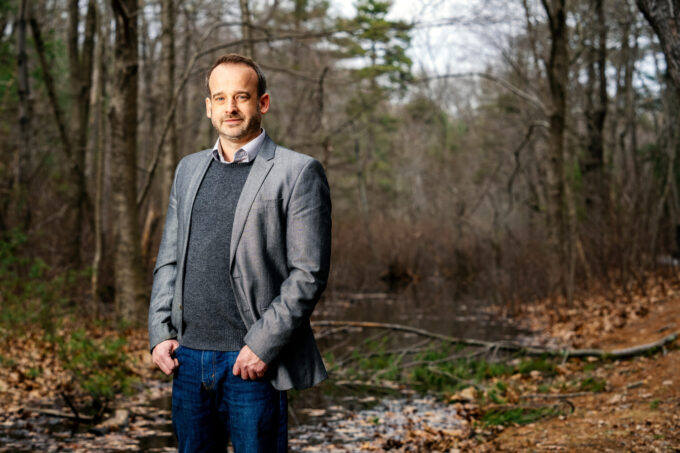Searching across deep time to understand “ecogenesis”

MIT geobiologist Greg Fournier seeks to uncover the conditions leading to the emergence of life. “Our work can help us to understand the time and evolutionary processes that can lead to that critical ‘ecogenesis’ stage, and to perhaps recognize it in other worlds,” he says. Image credit: M. Scott Brauer
In Greg Fournier’s line of work — studying living systems that developed billions of years ago — outstanding questions far outnumber established answers.
“Often, we have very little information to go on. We can suggest how each piece of evidence we have may be more consistent with different scenarios,” says Fournier, an associate professor of geobiology in MIT’s Department of Earth, Atmospheric and Planetary Sciences. “However, we must also be aware that our record of the past will always be incomplete, and many things are inherently unknowable. I find this level of mystery to be exciting rather than discouraging — as long as we can continue to explore new areas of knowledge.”
In a way, Fournier’s background offers the blueprint for who he is as a researcher. Growing up exploring the woods, ponds, and farmlands of his native home in rural Connecticut, he says he felt an “intimate and personal connection” to the natural world. His description of the path that brought him to where he is today sounds reminiscent of the evolutionary processes so central to his work.
“I do not think I was shaped by any single experience,” Fournier says. “Rather, it was a slow accumulation of experiences that reinforced particular perspectives, values, and interests, and created aversions to others.”
With a keen interest in the evolutionary relationships among living things, Fournier started to focus in graduate school on microbes and their metabolisms, many of which are connected to major life-supporting processes on Earth, including the production of oxygen through photosynthesis. Continuing in that area, last year he and his research team were able to estimate that photosynthesis evolved between 3.4 and 2.9 billion years ago. This process — “one of the most important metabolisms to ever evolve,” according to Fournier — represented a huge step toward Earth’s habitability and occurred when microbes called cyanobacteria developed the ability to turn sunlight and water into energy, releasing oxygen.
To reach this discovery, Fournier’s team developed a new technique to analyze genes, tracing living species of cyanobacteria back to a common ancestor that evolved about 2.9 billion years ago, and demonstrating that the ancestors of cyanobacteria branched off from other bacteria around 3.4 billion years ago.
The researchers derived these estimates by using fossil records and models called “molecular clocks,” which are based on the genetic sequences of microbes today and estimate how quickly genetic changes have occurred over time. Those methods were paired with discoveries of horizontal gene transfer (HGT) events, in which a gene jumps from one species to another. Discovering instances of HGT provides markers in the evolution of a species, which could then be matched with fossil records and the molecular clock models to solidify the dating estimates.
Fournier says he thinks the most exciting thing happening in his field is the integration of geochemistry and genomics, which he calls a “reuniting of fields across the natural sciences, bringing important knowledge and perspectives to very hard problems in understanding the history of the Earth system.”
By understanding Earth’s processes at the time when life first appeared, Fournier says we can better understand how life could begin on other planets: “Our work can help us to understand the time and evolutionary processes that can lead to that critical ‘ecogenesis’ stage, and to perhaps recognize it in other worlds.”
Fournier joined the faculty at MIT in 2014, becoming the Cecil and Ida Green Career Development Assistant Professor in 2016. In 2021 he received the Scialog: Signatures of Life in the Universe Collaborative Innovation Award, which aims to bring together scientists focused on the habitability of Earth and other planets. He was awarded tenure in May 2022.
He says creativity is an important element in his work, for both envisioning scenarios in deep time and coming up with ways to test their validity.
“The ‘envisioning’ requires a balance of both imagination and leveraging our prior knowledge about events in deep time,” he says. “I find that creativity is required most when coming up with good tests for these scenarios.”
Often, Fournier says, stoking this creativity actually involves moving away from his work.
“I often do my best thinking when I am well-rested and engaged in other activities,” he says. “For example, it can sometimes be very difficult to imagine solutions to a problem while sitting in my office, but the ideas will spontaneously flow while I am raking leaves or out kayaking. It is important to have time when the mind is free to wander.”
Similarly, Fournier says he encourages students approaching complicated problems not to be hemmed in “by the work that has come before you.”
“Understand it, learn from it,” he says, “and then try out some of your own ideas.”


